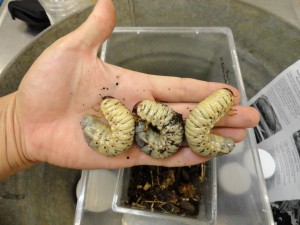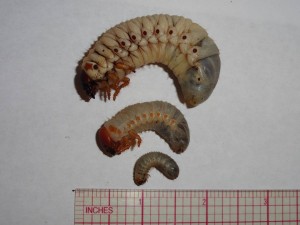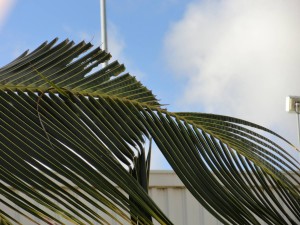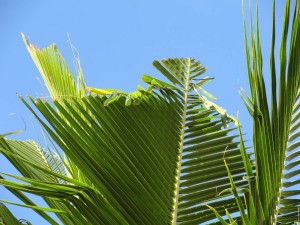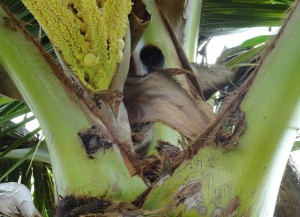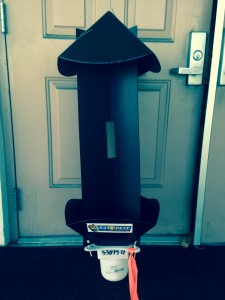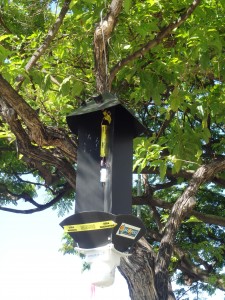Coconut Rhinoceros Beetle Information
Posted on Jan 15, 2014 in Main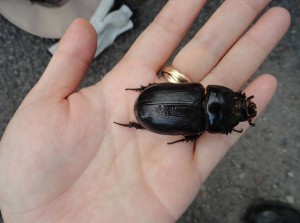 |
Coconut Rhinoceros Beetle (adult) |
VOLUNTARY STOP MOVEMENT ORDER ON CRB HOST MATERIAL ISSUED ON HAWAI‘I ISLAND TO STOP THE SPREAD OF CRB
On June 27, 2025, Mayor Kimo Alameda of the County of Hawai‘i, in coordination with the Hawai‘i Department of Agriculture (HDOA), issued a 90-day voluntary stop-movement order on CRB host material in areas on West Hawai‘i to help stop the spread of the invasive beetles. The affected areas are depicted below.
In the meantime, HDOA is preparing a proposed interim rule that will be presented to the Hawai‘i Board of Agriculture for approval.
Frequently Asked Question may be viewed at: https://dab.hawaii.gov/pi/files/2014/01/CRB-FAQs-6-30-2025.pdf
For more information, go to the news release at: https://dab.hawaii.gov/blog/main/hawaii-island-crb-stop-movement/ or go to the County of Hawai‘i website at: https://www.hawaiicounty.gov/Home/Components/News/News/4072/720
For questions about moving CRB host materials, please contact Glenn Sako, County Economic Development Specialist, at 808-961-8811.
*******
COCONUT RHINOCEROS BEETLES FOUND ON KAUAI
Two coconut rhinoceros beetles have been found on Kauai near Lihue Airport around the Lihue Transfer Station in late May and early June 2023. This is the first detection of CRB outside of Oahu. Crews from the Coconut Rhinoceros Beetle Response Team have been deployed to Kauai to aid in the surveying of the area. The County of Kauai has closed the green waste facility at the Lihue Transfer Station until further notice.
Link to the news releases for more information:
- June 8, 2023 – Coconut Rhinoceros Beetle Flyer for Kauai
- June 5, 2023 – Coconut Rhinoceros Beetles Detected on Kauai
The eradication efforts for the invasive coconut rhinoceros beetle continues on Oahu and residents are being asked to check their mulch piles and green waste for any breeding populations. In addition, mulch material should not be transported. Oahu residents are urged to call the CRB team for assistance at 808-679-5244.
More information may be found in the news release below.
DISLODGED CRB TRAPS
The public is asked to report CRB panel traps that may be blown down due to strong winds. Dislodged traps may be reported by either calling the CRB hotline at 808-679-5244 or by e-mail at: [email protected] . For more information, our website is crbhawaii.org .
More than 3,100 panel traps have been deployed around Oahu.
Mahalo!
NEWS RELEASES
- Mulch Piles May Breed CRB
Feb, 18, 2015 - CRB Found near Mililani
Oct. 21, 2014 - CRB Found at Diamond Head
Oct. 17, 2014 - Public Asked to Report Dislodged CRB Traps
Aug. 6, 2014 - Coconut Rhinoceros Beetle Found in Campbell Industrial Park
July 9, 2014 - Coconut Rhinoceros Beetle Found at Barbers Point
May 28, 2014
CRB IN HAWAI‘I
The Coconut Rhinoceros Beetle (CRB), a serious invasive pest, was detected on Dec. 23, 2013 on Joint Base Pearl Harbor – Hickam (JBPH-H) on coconut trees.
Since the detection, a joint effort between the U.S. Department of Agriculture (USDA), the University of Hawaii @ Manoa (UH), the U.S. Navy, the Hawaii Department of Agriculture (HDOA) and other partners have mobilized surveying, trapping and control efforts in the area where the beetle was found. The Incident Command System (ICS) has been established to help manage the various agencies and activities needed to efficiently respond to this pest emergency.
Since it was initially detected at JBPH-H, CRB have been found at Barbers Point in May 2014, Campbell Industrial Park in July 2014, and Diamond Head in Oct. 2014.
CRB is a major pest of palms in India, the Philippines, the Palaus, Fiji, Wallis, Nukunono, American and Western Samoa and Guam. CRB is native to the Asian tropics, but was accidentally introduced to western and central Pacific islands. It is not known exactly how the beetles arrived in Hawaii.
CRB is mainly a pest of coconut and oil palms, but may also attack other palm species. Adult CRB are dark brown in color and measure 1 ¼ to 2 ½ inches long. CRB larvae are white in color with a brown head. (See photos below)
They damage palms by boring into the center of the crown where they injure young, growing tissue and feed on the sap. As they bore into the crown, they cut through developing leaves, causing damage to the fronds. V-shaped cuts in the fronds and holes through the midrib are visible as leaves mature and unfold.
Suspected CRB on coconut and palm plants on all islands should be reported to HDOA’s PEST HOTLINE – 643-PEST (7378). This is also a toll-free number for neighbor islands.
* * * * * * * * * * * * * *
CRB INFORMATION
- NEW PEST ADVISORY for CRB (issued May 1, 2014)
- CRB Information – USDA
- BI-WEEKLY UPDATES FROM Hawaii Invasive Species Council
- CURRENT MAP OF CRB ACTIVITIES

